Free NCLEX Questions often incorporate scenarios involving ethical dilemmas, requiring students to apply ethical principles in their decision-making process.
NCLEX Upper Gastrointestinal Tract Questions
Upper Gastrointestinal Tract NCLEX Practice Questions
Question 1.
A nurse is caring for a client who has just returned from surgery to treat a fractured mandible. The jaws are wired. What should the nurse do if the client begins to vomit?
(a) Administer an antiemetic as prescribed.
(b) Cut the wires and assist the client expectorate.
(c) Have client sit up, bend over, and spit into an emesis basin.
(d) Insert a suction tube to clear the vomitus from the oral cavity.
Answer:
(c) Have client sit up, bend over, and spit into an emesis basin.
Explanation:
Following surgery for a fractured mandible, the client’s jaws will be wired. The nurse should be prepared to intervene quickly in case the client develops respiratory distress or begins to choke or vomit. If the client begins to vomit, the nurse should assist the client to a sitting position and have the client bend over and expectorate the emesis into an emesis basin. Wire cutters or scissors should always be available in case the wires need to be cut in a medical emergency, but are only used if the client cannot breathe or is choking. Suction equipment should be available to help clear the client’s airway if necessary, but this is not the first course of action. The nurse should administer the antiemetic if the client reports nausea, but the drug will not be effective if the client is already vomiting.
Question 2.
The nurse is teaching a client with stomatitis about managing oral discomfort. Which instruction is most appropriate?
(a) Drink hot tea at frequent intervals.
(b) Gargle with antiseptic mouthwash.
(c) Use an electric toothbrush.
(d) Eat a soft, bland diet.
Answer:
(d) Eat a soft, bland diet.
Explanation:
Clients with stomatitis (inflammation of the mouth) have significant discomfort, which impacts their ability to eat and drink. They will be most comfortable eating soft, bland foods and avoiding temperature extremes in their food and liquids. Gargling with an antiseptic mouthwash will be irritating to the mucosa. Mouth care should include gentle brushing with a soft toothbrush and flossing.
Question 3.
A client who has a history of bacterial endocarditis is scheduled to have oral surgery to remove a tooth. What should the nurse instruct the client to do?
(a) Gargle with a saline solution prior to the appointment.
(b) Rinse the mouth with mouthwash the night before and day of the surgery.
(c) Contact the health provider to request a sedative.
(d) Be sure the dentist prescribes a prophylactic antibiotic prior to the oral surgery.
Answer:
(d) Be sure the dentist prescribes a prophylactic antibiotic prior to the oral surgery.
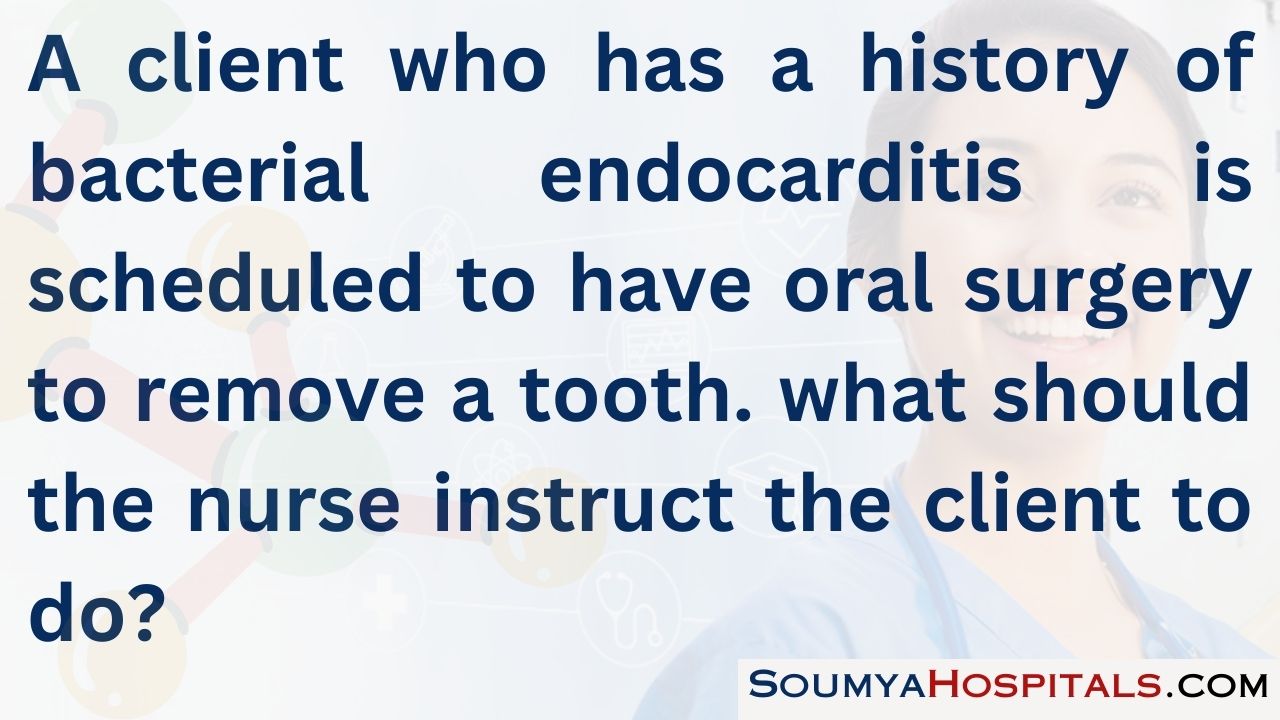
Explanation:
Clients who are at risk for developing infective endocarditis due to cardiac conditions such as
a history of bacterial endocarditis must take prophylactic antibiotics before any dental procedure that may cause bleeding. Gargling with saline or using mouthwash is not sufficient to prevent infection. The client will not need a sedative prior to the surgery.
Question 4.
Amoxicillin trihydrate 300 mg PO has been prescribed for a client with an oral infection. The medication is available in a liquid suspension that is available as 250 mg/5 mL. How many milliliters should the nurse administer? Record your answer using a whole number. ................... mL.
Answer:
6 ml,. To administer 300 mg PO, the nurse will need to administer 6 mL. The following formula is used to calculate the correct dosage:
300 mg/XmL = 250 mg/5 mL.
Question 5.
During the assessment of a client’s mouth, the nurse notes the absence of saliva. The client reports having pain in the ear. The client has been nothing-by-mouth (NPO) for several days but now can have liquids. What should the nurse do next?
(a) Request a prescription for an antifungal mouthwash.
(b) Instruct the client to brush the gums as well as the teeth.
(c) Encourage the client to suck on hard candy.
(d) Give the client a hydrogen peroxide-based mouthwash.
Answer:
(c) Encourage the client to suck on hard candy.
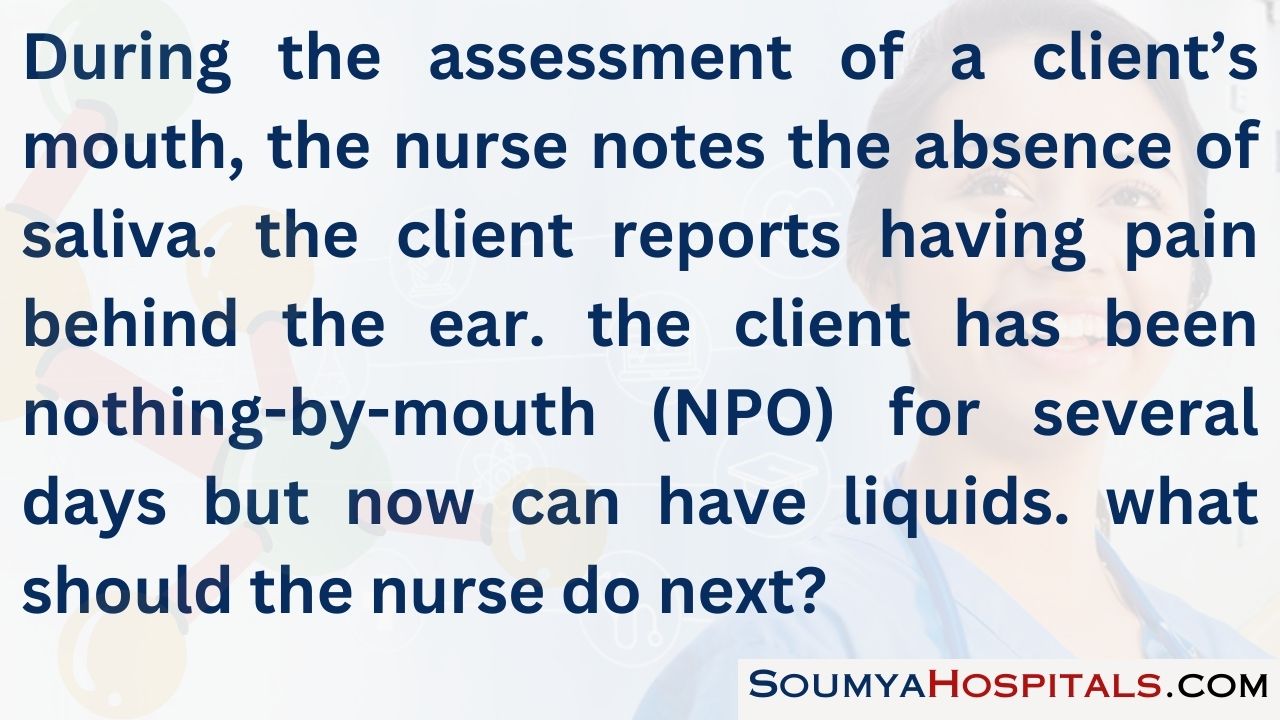
Explanation:
The lack of saliva, pain near the area of the ear, and the prolonged NPO status of the client are indications that the client may be developing parotitis or inflammation of the parotid gland. Parotitis usually develops with dehydration combined with poor oral hygiene or when clients have been NPO for an extended period. Preventive measures include the use of sugarless hard candy or gum to stimulate saliva production, adequate hydration, and frequent mouth care.
The client does not have indications of stomatitis (inflammation of the mouth), which produces excessive salivation and a sore mouth. The client does not have indications of oral candidiasis (thrush), which causes bluish-white mouth lesions, and the nurse does not need to request a prescription for an antifungal mouthwash. There are no indications that the client has gingivitis, which can be recognized by the inflamed gingiva and bleeding that occur during toothbrushing, and while the client should brush the teeth and gums, increasing salivation to prevent parotitis is the priority at this time.
Question 6.
The nurse is preparing a community presentation on oral cancer. Which is a primary risk factor for oral cancer that the nurse should emphasize in the presentation?
(a) use of alcohol
(b) frequent use of mouthwash
(c) lack of vitamin B12
(d) lack of regular teeth cleaning by a dentist
Answer:
(a) use of alcohol
Explanation:
Chronic and excessive use of alcohol can lead to oral cancer. Smoking and use of smokeless tobacco are other significant risk factors. Additional risk factors include chronic irritation such as a broken tooth or ill-fitting dentures, poor dental hygiene, overexposure to sun (lip cancer), and syphilis. Use of mouthwash, lack of vitamin B12, and lack of regular teeth cleaning appointments have not been implicated as primary risk factors for oral cancer.
Question 7.
A client has early signs of oral cancer. What should the nurse include in a focused assessment? Select all that apply.
(a) an infection or inflammation in the mouth
(b) lost the sense of taste
(c) difficulty swallowing
(d) significant weight loss
(e) changes in the frequency of urination
(f) numbness of the tongue
Answer:
(a) an infection or inflammation in the mouth
(c) difficulty swallowing
(d) significant weight loss
(f) numbness of the tongue
Explanation:
(a), (c), (d),(f). The nurse is conducting a focused assessment of the client’s mouth and ability to obtain nutrition. Therefore, the nurse focuses on inspecting the mouth for infection or inflammation, determining if the client has difficulty swallowing, and assuring nutrition by noting weight loss. A sign of oral cancer is numbness of the tongue; losing a sense of taste is not an early sign of oral cancer. Urinary output, while important, is not a part of a focused assessment of this health problem.
Question 8.
Following surgery to set a fractured mandible, the client has swelling at the surgery site. What is the priority goal of nursing care?
(a) Prevent nausea and vomiting.
(b) Maintain a patent airway.
(c) Provide frequent oral hygiene.
(d) Establish a way for the client to communicate.
Answer:
(b) Maintain a patent airway.
Explanation:
The priority of care in the immediate postoperative phase is to maintain a patent airway. The nurse should observe the client carefully for signs of respiratory distress. If the client becomes nauseated, antiemetics should be administered to decrease the chance of vomiting with obstruction of the airway and aspiration of vomitus. Providing frequent oral hygiene and an alternative means of communication are important aspects of nursing care, but maintaining a patent airway is most important.
Question 9.
A client is admitted to the hospital after vomiting bright red blood and is diagnosed with a bleeding duodenal ulcer. The client develops a sudden, sharp pain in the mid-epigastric region along with a rigid, board-like abdomen. After obtaining the client’s vital signs, what should the nurse do next?
(a) Administer pain medication as prescribed.
(b) Raise the head of the bed.
(c) Prepare to insert a nasogastric tube.
(d) Notify the health care provider (HCP).
Answer:
(d) Notify the health care provider (HCP).
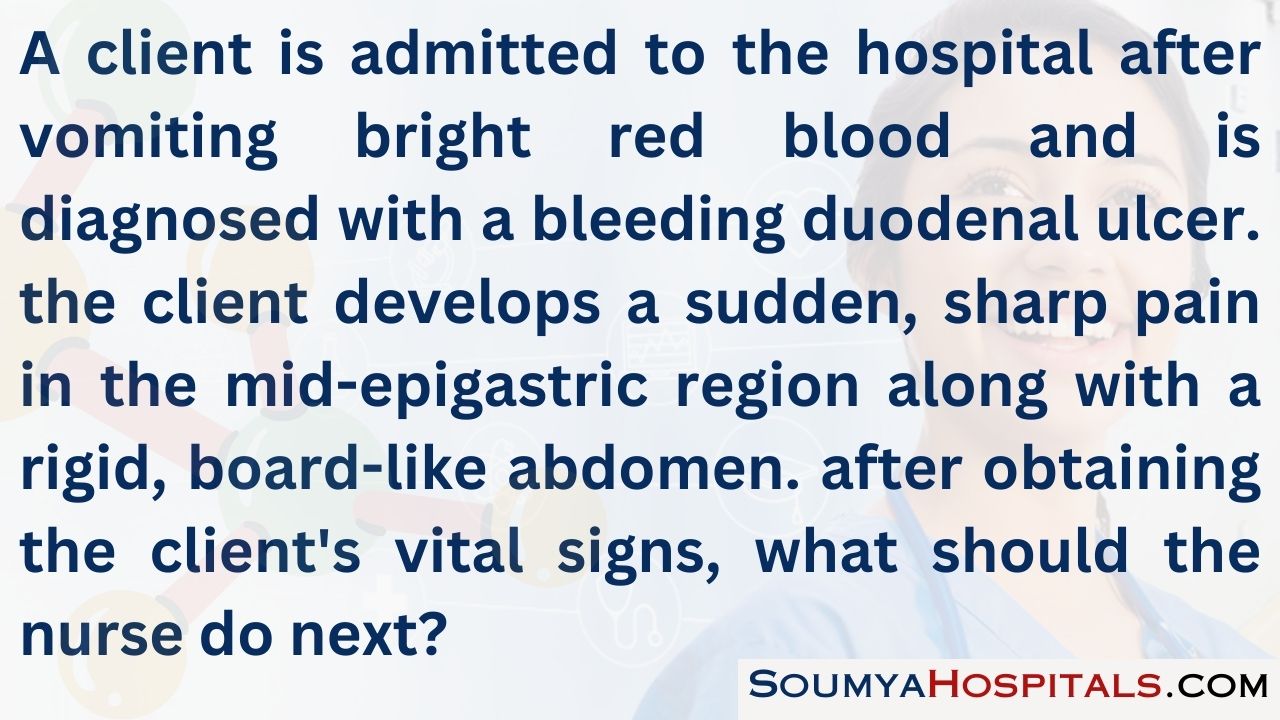
Explanation:
The client is experiencing a perforation of the ulcer, and the nurse should notify the HCP immediately. The body reacts to the perforation of an ulcer by immobilizing the area as much as possible. This results in board-like abdominal rigidity, usually with extreme pain. Perforation is a medical emergency requiring immediate surgical intervention because peritonitis develops quickly after perforation. Administering pain medication is not the first action, although the nurse later should institute measures to relieve pain. Elevating the head of the bed will not minimize the perforation. A nasogastric tube may be used following surgery.
Question 10.
When obtaining a nursing history from a client with a suspected gastric ulcer, which signs and symptoms should the nurse assess? Select all that apply.
(a) epigastric pain at night
(b) relief of epigastric pain after eating
(c) vomiting
(d) weight loss
(e) melena
Answer:
(c) vomiting
(d) weight loss
(e) melena
Explanation:
(c), (d), (e). Vomiting and weight loss are common with gastric ulcers. The client may also have blood in the stools (melena) from gastric bleeding. Clients with a gastric ulcer are most likely to have a burning epigastric pain that occurs about 1 hour after eating. Eating frequently aggravates the pain. Clients with duodenal ulcers are more likely to have pain that occurs during the night and is frequently relieved by eating.
Question 11.
The nurse is caring for a client who has had a gastroscopy. Which findings indicate that the client is developing a complication related to the procedure? Select all that apply.
(a) The client has a sore throat.
(b) The client has a temperature of 100°F (37.8°C).
(c) The client appears drowsy following the procedure.
(d) The client has epigastric pain.
(e) The client experiences hematemesis.
Answer:
(b) The client has a temperature of 100°F (37.8°C).
(d) The client has epigastric pain.
(e) The client experiences hematemesis.
Explanation:
(b), (d), (e). Following a gastroscopy, the nurse should monitor the client for complications, which include perforation and the potential for aspiration. An elevated temperature, epigastric pain, or the vomiting of blood (hematemesis) are all indications of a possible perforation and should be reported promptly. A sore throat is a common occurrence following a gastroscopy. Clients are usually sedated to decrease anxiety, and the nurse would anticipate that the client will be drowsy following the procedure.
Question 12.
A client admitted to the hospital with peptic ulcer disease tells the nurse about having black, tarry stools. What should the nurse do?
(a) Encourage the client to increase fluid intake.
(b) Advise the client to avoid iron-rich foods.
(c) Place the client on contact precautions.
(d) Report the finding to the health care provider (HCP).
Answer:
(d) Report the finding to the health care provider (HCP).
Explanation:
Black, tarry stools are an important warning sign of bleeding in peptic ulcer disease. Digested blood in the stool causes it to be black; the odor of the stool is very offensive. The nurse should instruct the client to report the incidence of black stools promptly to the HCP. Increasing fluids or avoiding iron-rich foods will not change the stool color or consistency if the stools contain digested blood. Until other information is available, it is not necessary to initiate contact precautions.
Question 13.
A client with peptic ulcer disease is taking ranitidine. What is the expected outcome of this drug?
(a) Heal the ulcer.
(b) Protect the ulcer surface from acids.
(c) Reduce acid concentration.
(d) Limit gastric acid secretion.
Answer:
(d) Limit gastric acid secretion.
Explanation:
Histamine2 (H2) receptor antagonists, such as ranitidine, reduce gastric acid secretion. Antisecretories, or proton pump inhibitors, such as omeprazole, help ulcers heal quickly in 4 to 8 weeks. Cytoprotective drugs, such as sucralfate, protect the ulcer surface against acid, bile, and pepsin. Antacids reduce acid concentration and help reduce symptoms.
Question 14.
A client with a peptic ulcer reports epigastric pain that frequently causes the client to wake up during the night. The nurse should instruct the client to do which activities? Select all that apply.
(a) Obtain adequate rest to reduce stimulation.
(b) Eat small, frequent meals throughout the day.
(c) Take all medications on time as prescribed.
(d) Sit up for 1 hour when awakened at night.
(e) Stay away from crowded areas.
Answer:
(a) Obtain adequate rest to reduce stimulation.
(b) Eat small, frequent meals throughout the day.
(c) Take all medications on time as prescribed.
(d) Sit up for 1 hour when awakened at night.
Explanation:
(a), (b), (c), (d). The nurse should encourage the client to reduce stimulation that may enhance gastric secretion. The nurse can also advise the client to utilize health practices that will prevent recurrences of ulcer pain, such as avoiding fatigue and elimination of smoking. Eating small, frequent meals helps to prevent gastric distention if not actively bleeding and decreases distention and release of gastrin. Medications should be administered promptly to maintain optimum levels. After awakening during the night, the client should eat a small snack and return to bed, keeping the head of the bed elevated for an hour after eating. It is not necessary to stay away from crowded areas.
Question 15.
A client with peptic ulcer disease reports being nauseated most of the day and now feeling light-headed and dizzy. Based upon these findings, which nursing actions would be most appropriate for the nurse to take? Select all that apply.
(a) administering an antacid hourly until nausea subsides
(b) monitoring the client’s vital signs
(c) notifying the health care provider (HCP) of the client’s symptoms
(d) initiating oxygen therapy
(e) reassessing the client in an hour
Answer:
(b) monitoring the client’s vital signs
(c) notifying the health care provider (HCP) of the client’s symptoms
Explanation:
(b), (c). The symptoms of nausea and dizziness in a client with peptic ulcer disease may be indicative of hemorrhage and should not be ignored. The appropriate nursing actions at this time are for the nurse to monitor the client’s vital signs and notify the HCP of the client’s symptoms. To administer an antacid hourly or to wait 1 hour to reassess the client would be inappropriate; prompt intervention is essential in a client who is potentially experiencing a gastrointestinal hemorrhage. The nurse would notify the HCP of assessment findings and then initiate oxygen therapy if prescribed by the HCP.
Question 16.
The nurse is teaching a client with a peptic ulcer about the diet that should be followed after discharge. What types of food should the nurse suggest the client include in the diet?
(a) bland foods
(b) high-protein foods
(c) any foods that are tolerated
(d) a glass of milk with each meal
Answer:
(c) any foods that are tolerated
Explanation:
Diet therapy for ulcer disease is a controversial issue. There is no scientific evidence that diet therapy promotes healing. Most clients are instructed to follow a diet that they can tolerate. There is no need for the client to ingest only a bland or high-protein diet. Milk may be included in the diet, but it is not recommended in excessive amounts.
Question 17.
A client diagnosed with peptic ulcer disease has an H. pylori infection. The client is following
a 2-week drug regimen that includes clarithromycin along with omeprazole and amoxicillin. How should the nurse instruct the client to take these medications?
(a) Alternate the use of the drugs.
(b) Take the drugs at different times during the day.
(c) Discontinue all drugs if nausea occurs.
(d) Take the drugs for the entire 2-week period.
Answer:
(d) Take the drugs for the entire 2-week period.
Explanation:
The use of the triple-therapy approach to the H. pylori infection has proved effective; therefore, the nurse advises the client to take the drugs as prescribed for the duration of the prescription. The nurse instructs the client to avoid alternating the use of the drugs and to take all medication at the same time, three times a day unless otherwise noted by the health care provider (HCP). Drugs have very few side effects; however, the nurse instructs the client to continue taking medications and contact the HCP if adverse effects occur.
Question 18.
A client with peptic ulcer disease is admitted to the hospital for a gastric resection. The client reports a sudden sharp pain in the midepigastric area that radiates to the shoulder. What should the nurse do first?
(a) Establish an IV line.
(b) Administer pain medication.
(c) Notify the surgeon.
(d) Call for a stat ECG.
Answer:
(c) Notify the surgeon.
Explanation:
The sharp, sudden midepigastric pain indicates the client may have a perforated ulcer. The nurse notifies the surgeon and may then obtain prescriptions for pain medication and IV fluids. It is not necessary to first obtain an ECG because the pain from ulcer perforation is different from that of chest pain that may indicate coronary artery syndrome (crushing pain radiating to the jaw).
Question 19.
A client is to take one daily dose of ranitidine at home to treat a peptic ulcer. Which response from the client indicates that the client understands how to take the medication?
I’ll take the drug:
(a) before meals.
(b) with meals.
(c) at bedtime.
(d) when pain occurs.
Answer:
(c) at bedtime.
Explanation:
Ranitidine blocks secretion of hydrochloric acid. Clients who take only one daily dose of ranitidine are usually advised to take it at bedtime to inhibit nocturnal secretion of acid. Clients who take the drug twice a day are advised to take it in the morning and at bedtime. It is not necessary to take the drug before meals. The client should take the drug regularly, not just when pain occurs.
Question 20.
A client has been taking aluminum hydroxide 30 mL six times per day at home to treat a peptic ulcer. The client has been unable to have a bowel movement for 3 days. What should the nurse determine is the most likely cause of the client’s constipation?
(a) The client has not been including enough fiber in the diet.
(b) The client needs to increase the daily exercise.
(c) The client is experiencing an adverse effect of the aluminum hydroxide.
(d) The client has developed a gastrointestinal obstruction.
Answer:
(c) The client is experiencing an adverse effect of the aluminum hydroxide.
Explanation:
It is most likely that the client is experiencing an adverse effect of the antacid. Antacids with aluminum salt products, such as aluminum hydroxide, form insoluble salts in the body. These precipitate and accumulate in the intestines, causing constipation. Increasing dietary fiber intake or daily exercise may be a beneficial lifestyle change for the client but is not likely to relieve the constipation caused by the aluminum hydroxide. Constipation, in isolation from other symptoms, is not a sign of a bowel obstruction.
Question 21.
A client is taking an antacid for treatment of a peptic ulcer. Which statement best indicates that the client understands how to correctly take the antacid?
(a) “I should take my antacid before I take my other medications.”
(b) “I need to decrease my intake of fluids so that I do not dilute the effects of my antacid.”
(c) “My antacid will be most effective if I take it whenever I experience stomach pains.”
(d) “It is best for me to take my antacid 1 to 3 hours after meals.”
Answer:
(d) “It is best for me to take my antacid 1 to 3 hours after meals.”
Explanation:
Antacids are most effective if taken 1 to 3 hours after meals and at bedtime. When an antacid is taken on an empty stomach, the duration of the drug’s action is greatly decreased. Taking antacids 1 to 3 hours after a meal lengthens the duration of action, thus increasing the therapeutic action of the drug. Antacids should be administered about 2 hours after other medications to decrease the chance of drug interactions. It is not necessary to decrease fluid intake when taking antacids. If antacids are taken more frequently than recommended, the likelihood of developing adverse effects increases. Therefore, the client should not take antacids as often as desired to control pain.
Question 22.
The nurse should assess the client who is being admitted to the hospital with upper GI bleeding for which finding? Select all that apply.
(a) dry, flushed skin
(b) decreased urine output
(c) tachycardia
(d) widening pulse pressure
(e) rapid respirations
(f) thirst
Answer:
(b) decreased urine output
(c) tachycardia
(e) rapid respirations
(f) thirst
Explanation:
(b), (c), (e),(f). The client who is experiencing upper GI bleeding is at risk for developing hypovolemic shock from blood loss. Therefore, the signs and symptoms the nurse should expect to find are those related to hypovolemia, including decreased urine output, tachycardia, rapid respirations, and thirst. The client’s skin would be cool and clammy, not dry, and flushed. The client would also be likely to develop hypotension, which would lead to a narrowing pulse pressure, not a widening pulse pressure.
Question 23.
A client with cancer of the stomach had a total gastrectomy 2 days earlier. Which indicates the client is ready to try a liquid diet?
(a) The client is hungry.
(b) The client has not requested pain medication for 8 hours.
(c) The client has frequent bowel sounds.
(d) The client has had a bowel movement.
Answer:
(c) The client has frequent bowel sounds.
Explanation:
The client can begin eating with a liquid diet when bowel sounds return, usually in 2 to 3 days. The client may be hungry but cannot have oral fluids or foods until intestinal motility has been established. The client may continue to have postoperative pain for several days; because receiving a liquid diet does not depend on the client being pain free, the nurse can continue to offer pain medication. The client does not have to experience a bowel movement to receive fluids and food.
Question 24.
Within 6 hours following a subtotal gastrectomy, the drainage from the client’s NG tube is bright red. What should the nurse do first?
(a) Clamp the NG tube.
(b) Remove the existing NG tube.
(c) Irrigate the NG tube with iced saline.
(d) Chart the finding in the client’s medical record.
Answer:
(d) Chart the finding in the client’s medical record.
Explanation:
NG drainage is expected to be bright red during the first 12 hours after surgery and then darken within 24 hours. The nurse notes the color of the drainage on the medical record and then monitors the change of color of the drainage throughout the immediate postoperative period. To prevent stress on the suture line, NG suction is applied and patency of the tube maintained. Removal of the NG tube may traumatize the surgical site. The NG tube is irrigated only if the health care provider (HCP) prescribes irrigation because there is danger of injury to the suture line; saline at room temperature is usually prescribed.
Question 25.
Since the diagnosis of stomach cancer, the client has been having trouble sleeping and is frequently preoccupied with thoughts about how life will change. The client says, “I wish my life could stay the same.” The nurse determines that the client is experiencing which problem?
(a) having difficulty coping
(b) experiencing a sleep disorder
(c) going through a grieving process
(d) showing signs of anxiety
Answer:
(b) experiencing a sleep disorder
Explanation:
A Billroth II procedure bypasses the duodenum and connects the gastric stump directly to the jejunum. The pyloric sphincter is removed, along with some of the stomach fundus.
Question 26.
A client has had a subtotal gastrectomy and has a nasogastric tube with intermittent suction. Twenty-four hours after the surgery, the drainage in the client’s nasogastric tube is dark brown. What should the nurse do?
(a) Reassure the client that this is normal drainage.
(b) Irrigate the nasogastric tube.
(c) Notify the health care provider (HCP).
(d) Discontinue the suction.
Answer:
(a) Reassure the client that this is normal drainage.
Explanation:
About 12 to 24 hours after a subtotal gastrectomy, gastric drainage is normally brown, which indicates digested blood; the nurse can reassure the client that this is a normal color. The nasogastric tube does not need to be irrigated as it is draining normally. It is not necessary to notify the HCP unless the drainage contains bright red blood. The nurse should continue the suction until the HCP indicates to discontinue, usually when the drainage has stopped.
Question 27.
Following a subtotal gastrectomy, a client has a nasogastric (NG) tube connected to low suction. What should the nurse do?
(a) Irrigate the tube with 30 mL of sterile water every hour, if needed.
(b) Reposition the tube if it is not draining well.
(c) Monitor the client for nausea, vomiting, and abdominal distention.
(d) Change to high suction if the drainage is sluggish on low suction.
Answer:
(c) Monitor the client for nausea, vomiting, and abdominal distention.
Explanation:
Nausea, vomiting, or abdominal distention indicates that gas and secretions are accumulating within the gastric pouch due to impaired peristalsis or edema at the operative site and may indicate that the drainage system is not working properly. Saline is used to irrigate NG tubes. Hypotonic solutions such as water increase electrolyte loss. In addition, a health care provider’s (HCP) prescription is needed to irrigate the NG tube because this procedure could disrupt the suture line. After gastric surgery, only the surgeon repositions the NG tube because of the danger of rupturing or dislodging the suture line. The amount of suction varies with the type of tube used and is prescribed by the HCP. High suction may create too much tension on the gastric suture line.
Question 28.
A client who is recovering from gastric surgery is receiving IV fluids to be infused at 100 mL/h. The IV tubing delivers 15 gtt/mL. The nurse should infuse the solution at a flow rate of how many drops per minute to ensure that the client receives 100 mL/h? Record your answer using a whole number.
........................... gtt/min.
Answer:
25 gtt/min. To administer IV fluids at 100 mL/h using tubing that has a drip factor of
15 gtt/mL, the nurse should use the following formula:
100 mL/60 minutes x 15 gtts/1 mL = 25 gtt/min.
Question 29.
Following a gastrectomy, the nurse should place the client in which position?
(a) prone
(b) supine
(c) low Fowler’s
(d) right or left Sims’
Answer:
(c) low Fowler’s
Explanation:
A client who has had abdominal surgery is best placed in a low Fowler’s position postoperatively. This positioning relaxes abdominal muscles and provides for maximum respiratory and cardiovascular function. The prone, supine, or Sims’ position would not be tolerated by a client who has had abdominal surgery, nor do those positions support respiratory or cardiovascular functioning.
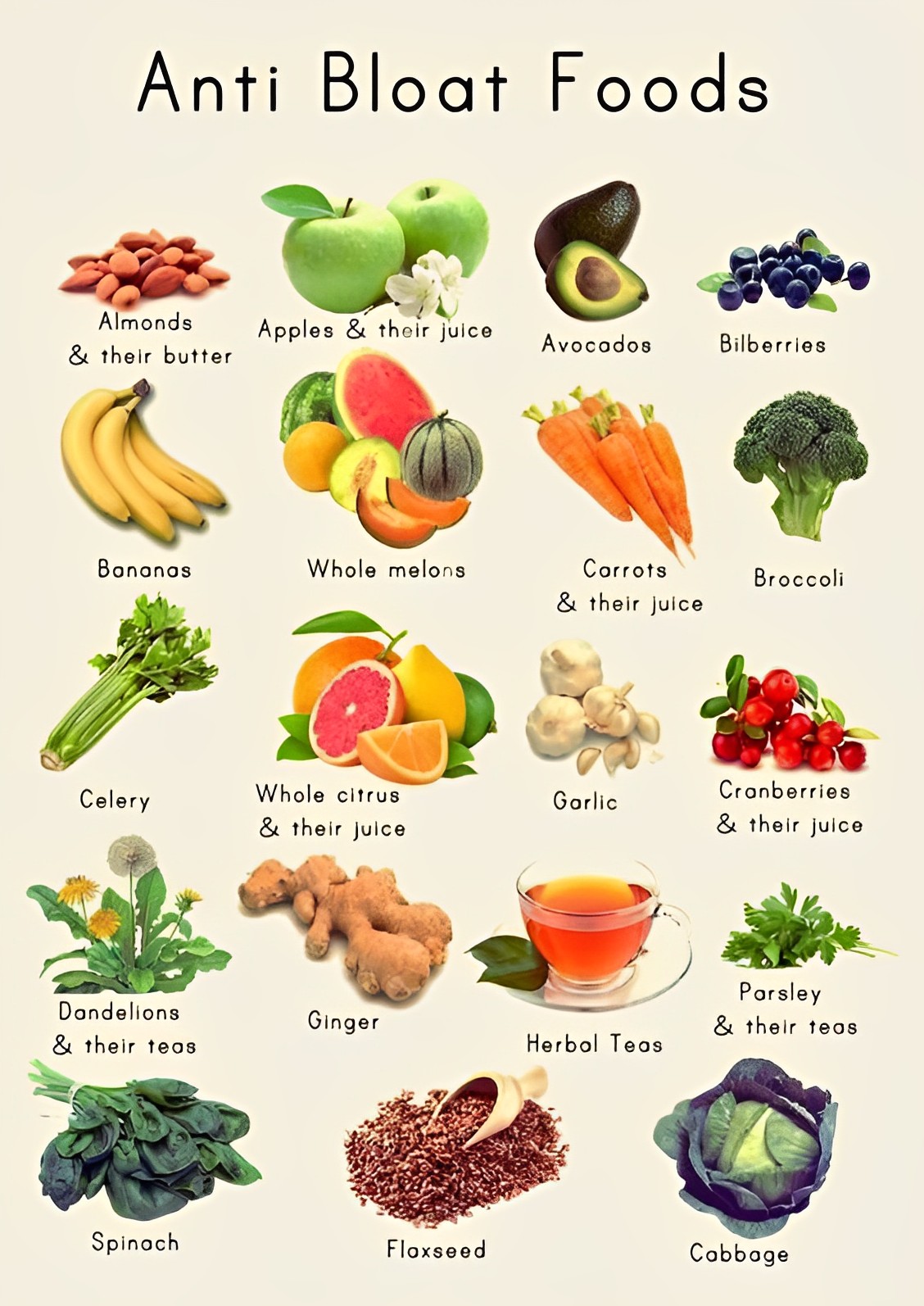
Question 30.
To reduce the risk of dumping syndrome, what should the nurse teach the client to do?
(a) Sit upright for 30 minutes after meals.
(b) Drink liquids with meals, avoiding caffeine.
(c) Avoid milk and other dairy products.
(d) Decrease the carbohydrate content of meals.
Answer:
(d) Decrease the carbohydrate content of meals.
Explanation:
Carbohydrates are restricted, but protein, including meat and dairy products, is recommended because it is digested more slowly. Lying down for 30 minutes after a meal is encouraged to slow the movement of the food bolus. Fluids are restricted to reduce the bulk of food. There is no need to avoid caffeine.
Question 31.
A client who is recovering from a subtotal gastrectomy experiences dumping syndrome and is to eat six small meals a day. The client asks the nurse, “When will I be able to eat three meals a day again like I used to?” Which response by the nurse is most appropriate?
(a) “Eating six meals a day is time-consuming, isn’t it?”
(b) “You will have to eat six small meals a day for the rest of your life.”
(c) “You will be able to tolerate three meals a day before you are discharged.”
(d) “Most clients can resume their normal meal patterns in about 6 to 12 months.”
Answer:
(d) “Most clients can resume their normal meal patterns in about 6 to 12 months.”
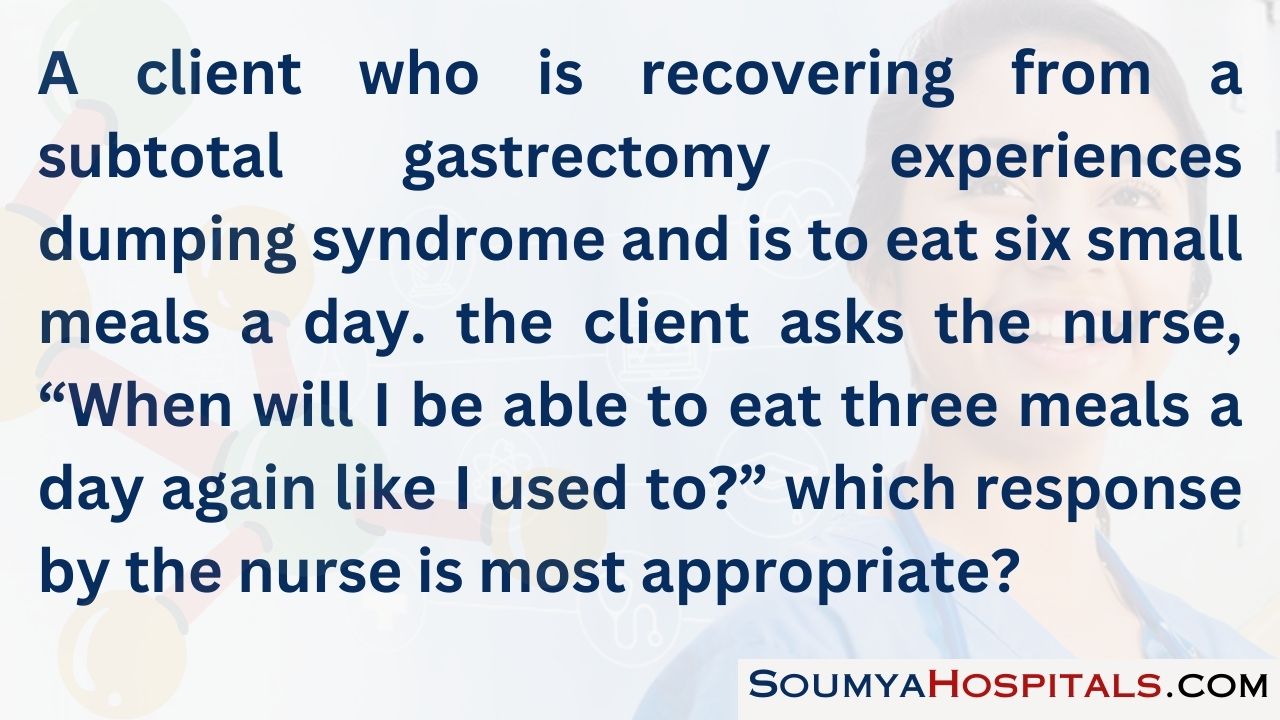
Explanation:
The symptoms related to dumping syndrome that occur after a gastrectomy usually disappear by 6 to 12 months after surgery. Most clients can begin to resume normal meal patterns after signs of the dumping syndrome have stopped. Acknowledging that eating six meals a day is time-consuming does not address the client’s question and makes an assumption about the client’s concerns. It is not necessarily true that a six-meal-a-day dietary pattern will be required for the rest of the client’s life. Clients will not be able to eat three meals a day before hospital discharge.
Question 32.
After a gastric resection cancer, a client is scheduled to undergo radiation therapy. What is the most important information the nurse should include in the discharge teaching plan?
(a) how to maintain adequate nutrition
(b) what do for alopecia
(c) how to exercise to attain activity goals
(d) where to access to community resources
Answer:
(a) how to maintain adequate nutrition
Explanation:
Clients who have had gastric surgery are prone to postoperative complications, such as dumping syndrome and postprandial hypoglycemia, which can affect nutritional intake. Vitamin absorption can also be an issue, depending on the extent of the gastric surgery. Radiation therapy to the upper gastrointestinal area also can affect nutritional intake by causing anorexia, nausea, and esophagitis. The client would not be expected to develop alopecia. Exercise and activity levels as well as access to community resources are important teaching areas, but nutritional intake is a priority need.
Question 33.
One month following a subtotal gastrectomy for cancer, the nurse is evaluating the nursing care goal related to improved nutrition. What indicates that the client has attained the goal?
(a) The client has regained weight loss.
(b) The client has resumed normal dietary intake of three meals a day.
(c) The client has controlled nausea and vomiting through regular use of antiemetics.
(d) The client has achieved adequate nutritional status through oral or parenteral feedings.
Answer:
(d) The client has achieved adequate nutritional status through oral or parenteral feedings.
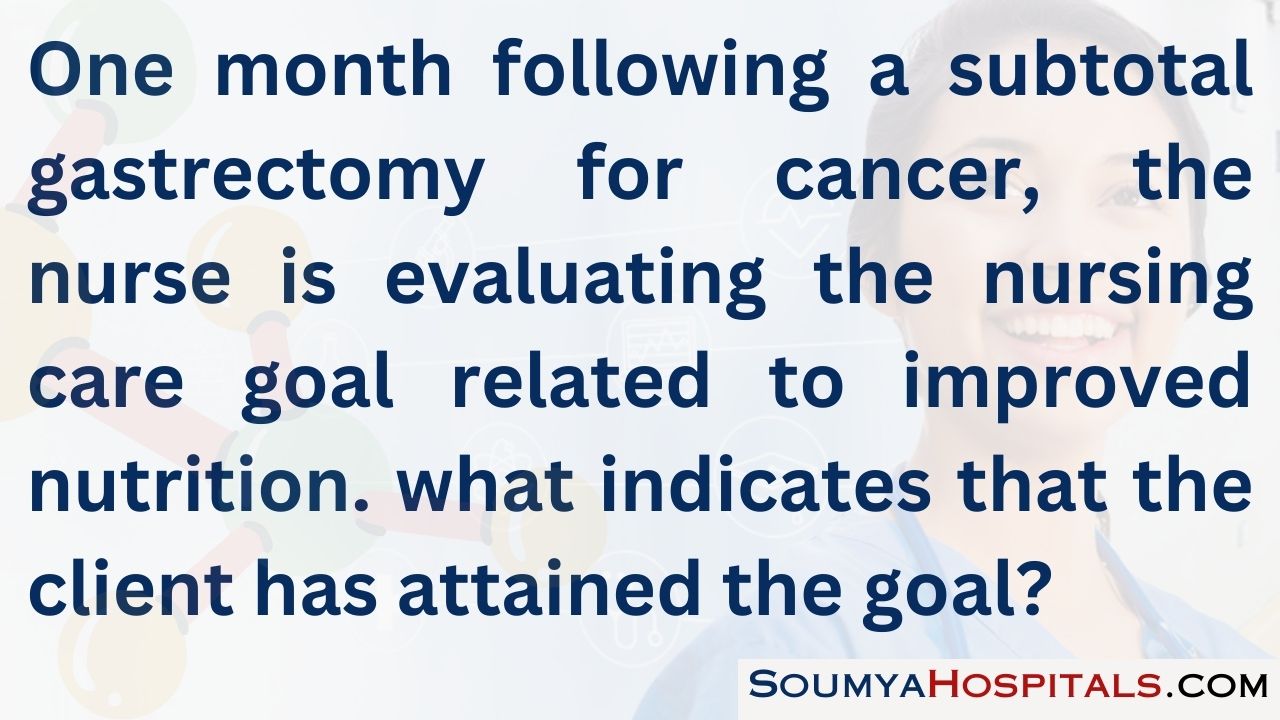
Explanation:
An appropriate expected outcome is for the client to achieve optimal nutritional status through the use of oral feedings or total parenteral nutrition (TPN). TPN may be used to supplement oral intake, or it may be used alone if the client cannot tolerate oral feedings. The client would not be expected to regain lost weight within 1 month after surgery or to tolerate a normal dietary intake of three meals a day. Nausea and vomiting would not be considered an expected outcome of gastric surgery, and regular use of antiemetics would not be anticipated.
Question 34.
Which instruction should the nurse include in the teaching plan for a client who is experiencing gastroesophageal reflux disease?
(a) Limit caffeine intake to two cups of coffee per
day.
(b) Do not lie down for 2 hours after eating.
(c) Follow a low-protein diet.
(d) Take medications with milk to decrease irritation.
Answer:
(c) Follow a low-protein diet.
Explanation:
The nurse should instruct the client to not lie down for about 2 hours after eating to prevent reflux. Caffeinated beverages decrease pressure in the lower esophageal sphincter, and milk increases gastric acid secretion, so these beverages should be avoided. The client is encouraged to follow a high-protein, low-fat diet and avoid foods that are irritating.
Question 35.
The client is scheduled to have an upper gastrointestinal tract series of X-rays. Following the X-rays, what should the nurse instruct the client to do?
(a) Take a laxative.
(b) Follow a clear liquid diet.
(c) Administer an enema.
(d) Take an antiemetic.
Answer:
(a) Take a laxative.
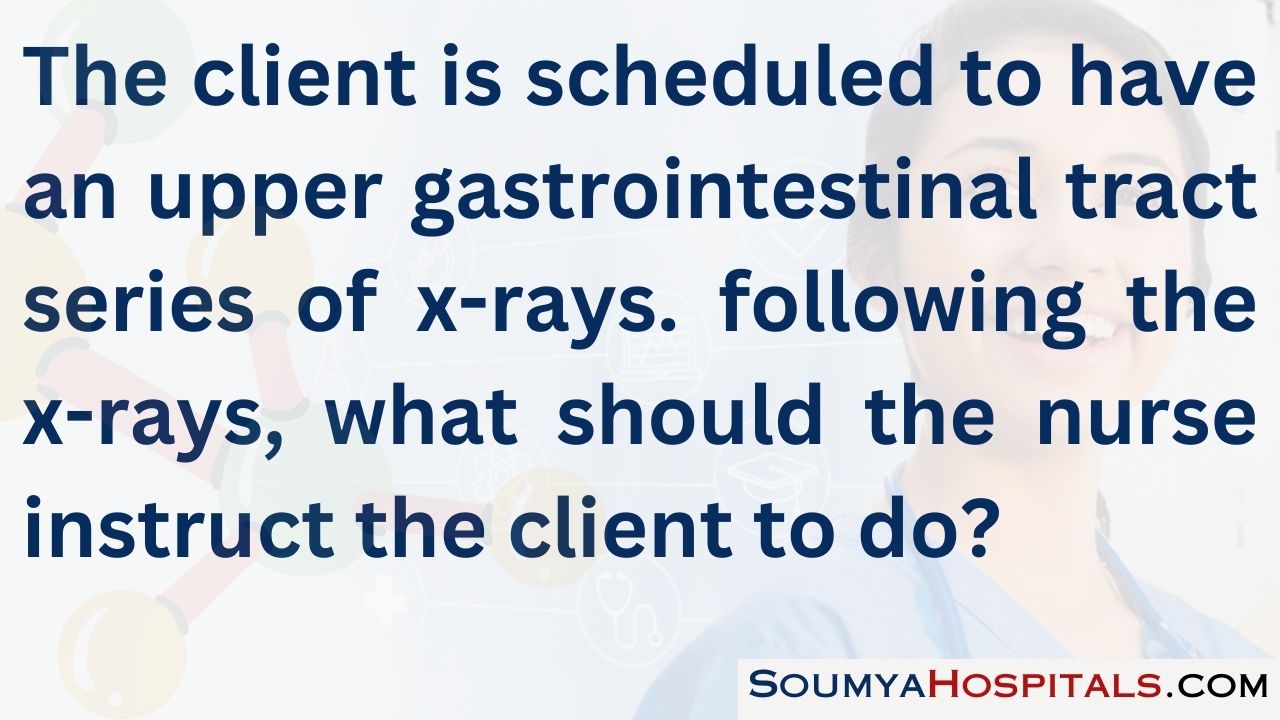
Explanation:
The client should take a laxative after an upper gastrointestinal series to stimulate a bowel movement. This examination involves the administration of barium, which must be promptly eliminated from the body because it may harden and cause an obstruction. A clear liquid diet would have no effect on stimulating the removal of the barium. The client should not have nausea, and an antiemetic would not be necessary; additionally, the antiemetic will decrease peristalsis and increase the likelihood of eliminating the barium. An enema would be ineffective because the barium is too high in the gastrointestinal tract.
Question 36.
A client who has been diagnosed with gastroesophageal reflux disease (GERD) has heartburn. To decrease the heartburn, the nurse should instruct the client to eliminate which item from the diet.
(a) lean beef
(b) air-popped popcorn
(c) hot chocolate
(d) raw vegetables
Answer:
(c) hot chocolate
Explanation:
With GERD, eating substances that decrease lower esophageal sphincter pressure causes heartburn. A decrease in the lower esophageal sphincter pressure allows gastric contents to reflux into the lower end of the esophagus. Foods that can cause a decrease in esophageal sphincter pressure include fatty foods, chocolate, caffeinated beverages, peppermint, and alcohol. A diet high in protein and low in fat is recommended for clients with GERD. Lean beef, popcorn, and raw vegetables would be acceptable.
Question 37.
The client with gastroesophageal reflux disease (GERD) has a chronic cough. The nurse should further assess the client for which other possible problem?
(a) development of laryngeal cancer
(b) irritation of the esophagus
(c) esophageal scar tissue formation
(d) aspiration of gastric contents
Answer:
(d) aspiration of gastric contents
Explanation:
Clients with GERD can develop pulmonary symptoms, such as coughing, wheezing, and dyspnea, that are caused by the aspiration of gastric contents. GERD does not predispose the client to the development of laryngeal cancer. Irritation of the esophagus and esophageal scar tissue formation can develop as a result of GERD. However, GERD is more likely to cause painful and difficult swallowing.
Question 38.
Bethanechol has been prescribed for a client with gastroesophageal reflux disease (GERD). The nurse should assess the client for which adverse effect?
(a) constipation
(b) urinary urgency
(c) hypertension
(d) dry oral mucosa
Answer:
(b) urinary urgency
Explanation:
Bethanechol, a cholinergic drug, may be used in GERD to increase lower esophageal sphincter pressure and facilitate gastric emptying. Cholinergic adverse effects may include urinary urgency, diarrhea, abdominal cramping, hypotension, and increased salivation. To avoid these adverse effects, the client should be closely monitored to establish the minimum effective dose.
Question 39.
The nurse is developing a care management plan with a client who has been diagnosed with gastroesophageal reflux disease. What should the nurse instruct the client to do? Select all that apply.
(a) Avoid a diet high in fatty foods.
(b) Avoid beverages that contain caffeine.
(c) Eat three meals a day, with the largest meal being at dinner in the evening.
(d) Avoid all alcoholic beverages.
(e) Lie down after consuming each meal for 30 minutes.
(f) Use over-the-counter (OTC) antisecretory agents rather than prescriptions.
Answer:
(a) Avoid a diet high in fatty foods.
(b) Avoid beverages that contain caffeine.
(d) Avoid all alcoholic beverages.
Explanation:
(a), (b), (d). No specific diet is necessary, but foods that cause reflux are avoided, including fatty foods (which decrease the rate of gastric emptying) and foods that decrease lower esophageal sphincter pressure such as chocolate, peppermint, coffee, and tea. The client should also avoid alcohol. The client should not lie down for 3 to 4 hours after eating. Antisecretory agents decrease the secretion of hydrochloric acid by the stomach; some are available in both OTC and prescription formulations, but the OTC preparations have lower drug dosages compared with prescription drugs. Cimetidine, ranitidine, famotidine, and nizatidine are available in both formulations.
Question 40.
Which dietary measure would be useful in preventing esophageal reflux?
(a) eating small, frequent meals
(b) increasing fluid intake
(c) avoiding air swallowing with meals
(d) adding a bedtime snack to the dietary plan
Answer:
(a) eating small, frequent meals
Explanation:
Esophageal reflux worsens when the stomach is overdistended with food. Therefore, an important measure is to eat small, frequent meals. Fluid intake should be decreased during meals to reduce abdominal distention. Avoiding air swallowing does not prevent esophageal reflux. Food intake in the evening should be strictly limited to reduce the incidence of nighttime reflux, so bedtime snacks are not recommended.
Question 41.
The nurse is obtaining a health history from a client who has a sliding hiatal hernia associated with reflux. The nurse should ask the client about the presence of which symptom?
(a) heartburn
(b) jaundice
(c) anorexia
(d) stomatitis
Answer:
(a) heartburn
Explanation:
Heartburn, the most common symptom of a sliding hiatal hernia, results from reflux of gastric secretions into the esophagus. Regurgitation of gastric contents and dysphagia are other common symptoms. Jaundice, which results from a high concentration of bilirubin in the blood, is not associated with hiatal hernia. Anorexia is not a typical symptom of hiatal hernia. Stomatitis is inflammation of the mouth.
Question 42.
Which risk factor would most likely contribute to the development of a hiatal hernia?
(a) having a sedentary desk job
(b) being 5 feet, 3 inches tall (160 cm) and weighing 190 lb (86.2 kg)
(c) using laxatives frequently
(d) being 40 years old
Answer:
(b) being 5 feet, 3 inches tall (160 cm) and weighing 190 lb (86.2 kg)
Explanation:
Any factor that increases intra-abdominal pressure, such as obesity, can contribute to the development of hiatal hernia. Other factors include abdominal straining, frequent heavy lifting, and pregnancy. Hiatal hernia is also associated with older age and occurs in women more frequently than in men. Having a sedentary desk job, using laxatives frequently, or being 40 years old is not likely to be a contributing factor in development of a hiatal hernia.
Question 43.
Which nursing intervention would most likely promote self-care behaviors in the client with a hiatal hernia?
(a) Introduce the client to other people who are successfully managing their care.
(b) Include the client’s daughter in the teaching so that she can help implement the plan.
(c) Ask the client to identify other situations in which the client changed health care habits.
(d) Provide reassurance that the client will be able to implement all aspects of the plan successfully.
Answer:
(c) Ask the client to identify other situations in which the client changed health care habits.
Explanation:
Self-responsibility is the key to individual health maintenance. Using examples of situations in which the client has demonstrated self-responsibility can be reinforcing and supporting. The client has ultimate responsibility for personal health habits. Meeting other people who are managing their care and involving family members can be helpful, but individual motivation is more important. Reassurance can be helpful but is less important than individualization of care.
Question 44.
The client has been taking magnesium hydroxide (milk of magnesia) to control hiatal hernia symptoms. The nurse should assess the client for which condition is most commonly associated with the ongoing use of magnesium-based antacids?
(a) anorexia
(b) weight gain
(c) diarrhea
(d) constipation
Answer:
(c) diarrhea
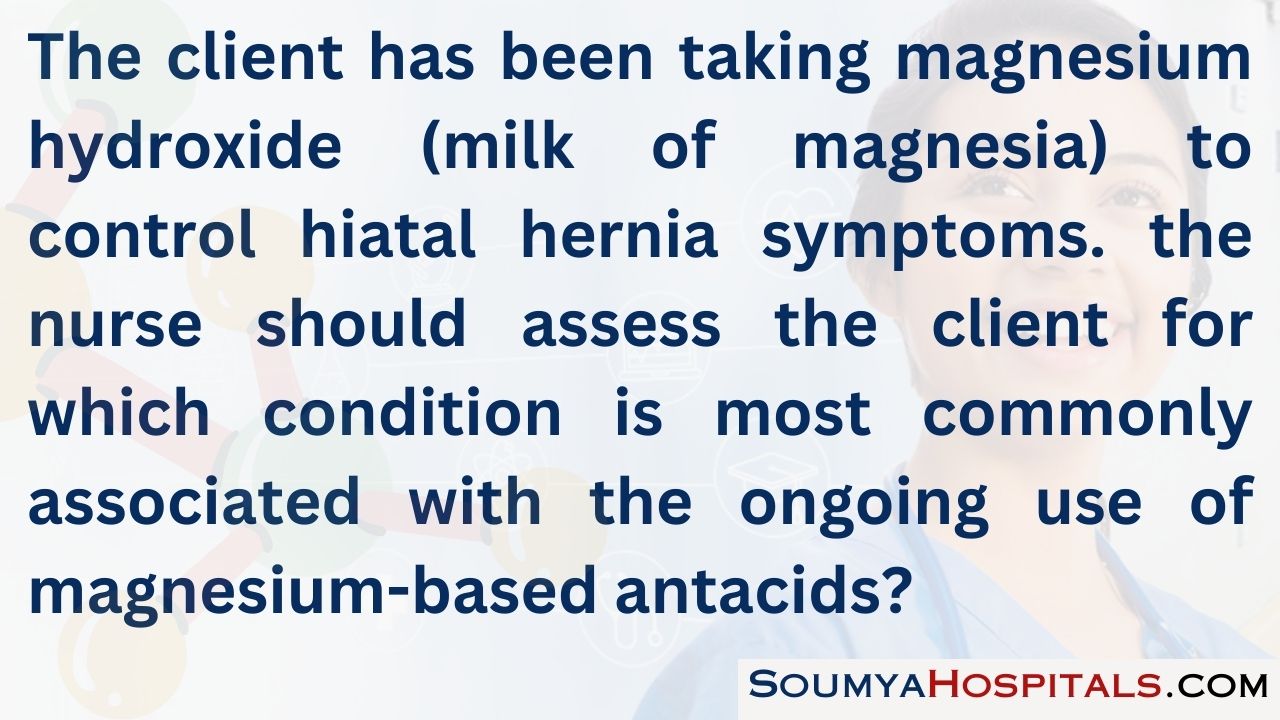
Explanation:
The magnesium salts in magnesium hydroxide are related to those found in laxatives and may cause diarrhea. Aluminum salt products can cause constipation. Many clients find that a combination product is required to maintain normal bowel elimination. The use of magnesium hydroxide does not cause anorexia or weight gain.
Question 45.
Which lifestyle modification should the nurse encourage the client with a hiatal hernia to include in activities of daily living?
(a) engaging in daily aerobic exercise
(b) eliminating smoking and alcohol use
(c) balancing activity and rest
(d) avoiding high-stress situations
Answer:
(b) eliminating smoking and alcohol use
Explanation:
Smoking and alcohol use both reduce esophageal sphincter tone and can result in reflux. They therefore should be avoided by clients with hiatal hernia. Daily aerobic exercise, balancing activity and rest, and avoiding high-stress situations may increase the client’s general health and well-being, but they are not directly associated with hiatal hernia.
Question 46.
In developing a teaching plan for the client with a hiatal hernia, the nurse’s assessment of which work-related factors would be most useful.
(a) number and length of breaks
(b) body mechanics used in lifting
(c) temperature in the work area
(d) cleaning solvents used
Answer:
(b) body mechanics used in lifting
Explanation:
Bending, especially after eating, can cause gastroesophageal reflux. Lifting heavy objects increases intra-abdominal pressure. Assessing the client’s lifting techniques enables the nurse to evaluate the client’s knowledge of factors contributing to hiatal hernia and how to prevent complications. The number and length of breaks, temperature in the work area, and cleaning solvents used are not directly related to the treatment of hiatal hernia.
Question 47.
The nurse instructs the client on health maintenance activities to help control symptoms from a hiatal hernia. Which statement would indicate that the client has understood the instructions?
(a) “I will avoid lying down after a meal.”
(b) “I can still enjoy my potato chips and cola at bedtime.”
(c) “I wish I did not have to give up swimming.”
(d) “If I wear a girdle, I will have more support for my stomach.”
Answer:
(a) “I will avoid lying down after a meal.”
Explanation:
A client with a hiatal hernia should avoid the recumbent position immediately after meals to minimize gastric reflux. Bedtime snacks, as well as high-fat foods and carbonated beverages, should be avoided. Excessive vigorous exercise also should be avoided, especially after meals, but there is no reason why the client must give up swimming. Wearing tight, constrictive clothing such as a girdle can increase intra-abdominal pressure and thus lead to reflux of gastric juices.
Question 48.
The nurse should instruct the client to avoid taking which drug while taking metoclopramide hydrochloride?
(a) antacids
(b) antihypertensives
(c) anticoagulants
(d) central nervous system depressants
Answer:
(d) central nervous system depressants
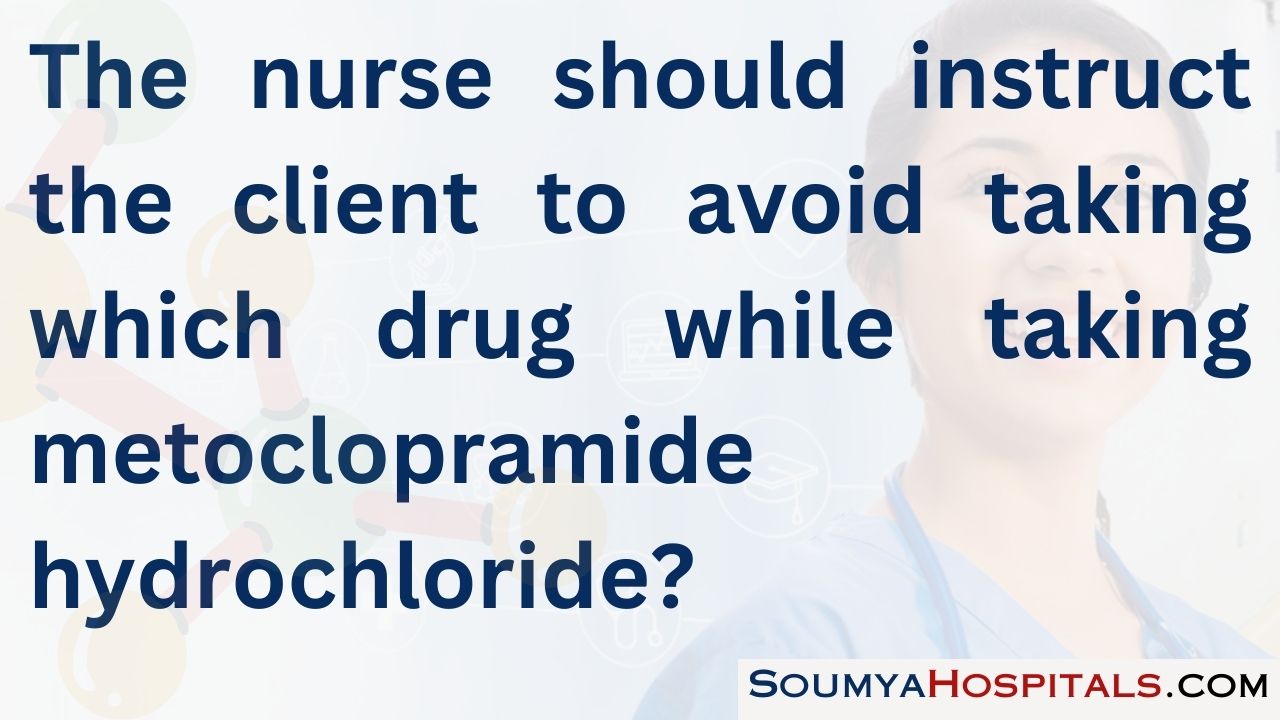
Explanation:
Metoclopramide hydrochloride can cause sedation. Alcohol and other central nervous system depressants add to this sedation. A client who is taking this drug should be cautioned to avoid driving or performing other hazardous activities for a few hours after taking the drug. Clients may take antacids, antihypertensives, and anticoagulants while on metoclopramide.
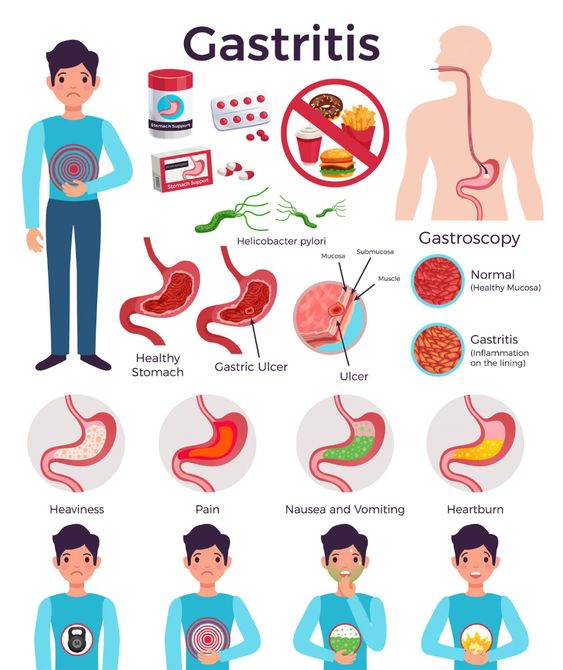
Question 49.
A client is taking cimetidine to treat a hiatal hernia. The nurse should evaluate the client to determine that the drug has been effective in preventing which health problem?
(a) esophageal reflux
(b) dysphagia
(c) esophagitis
(d) ulcer formation
Answer:
(c) esophagitis
Explanation:
Cimetidine is a histamine receptor antagonist that decreases the quantity of gastric secretions. It may be used in hiatal hernia therapy to prevent or treat the esophagitis and heartburn associated with reflux. Cimetidine is not used to prevent reflux, dysphagia, or ulcer development.
Question 50.
The client asks the nurse if surgery is needed to correct a hiatal hernia. Which reply by the nurse would be most accurate?
(a) “Surgery is usually required, although medical treatment is attempted first.”
(b) “Hiatal hernia symptoms can usually be successfully managed with diet modifications medications, and lifestyle changes.”
(c) “Surgery is not performed for this type of hernia.”
(d) “A minor surgical procedure to reduce the size of the diaphragmatic opening will probably be planned.”
Managing Care, Quality, and Safety of Clients with Upper Gastrointestinal Tract Health Problems
Answer:
(b) “Hiatal hernia symptoms can usually be successfully managed with diet modifications medications, and lifestyle changes.”
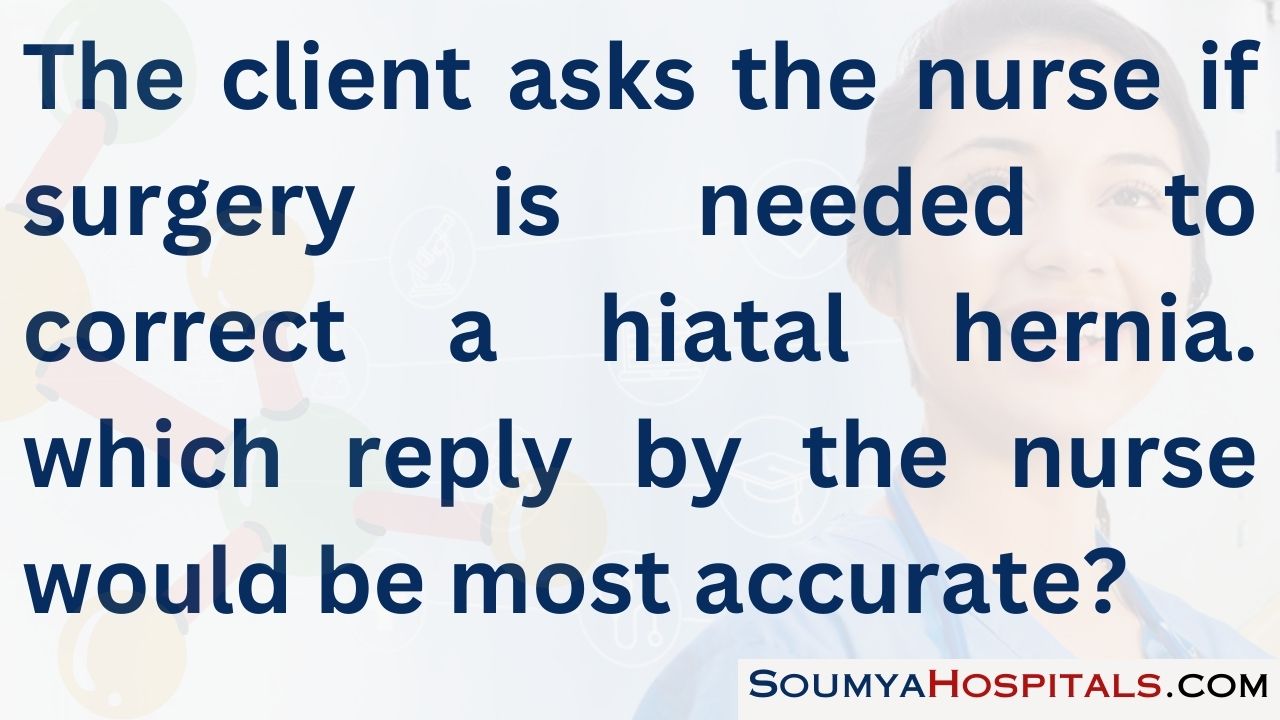
Explanation:
Most clients can be treated successfully with a combination of diet restrictions, medications, weight control, and lifestyle modifications. Surgery to correct a hiatal hernia, which commonly produces complications, is performed only when medical therapy fails to control the symptoms.
Question 51.
A client has returned from surgery during which the jaws were wired as a treatment for a fractured mandible. The client is in stable condition. The nurse is instructing the unlicensed assistive personnel (UAP) on how to properly position the client. Which instructions about positioning would be appropriate for the nurse to give the UAP?
(a) Keep the client in a side-lying position with the head slightly elevated.
(b) Do not reposition the client without the assistance of a registered nurse (RN).
(c) The client can assume any position that is comfortable.
(d) Keep the client’s head elevated on two pillows at all times.
Answer:
(a) Keep the client in a side-lying position with the head slightly elevated.
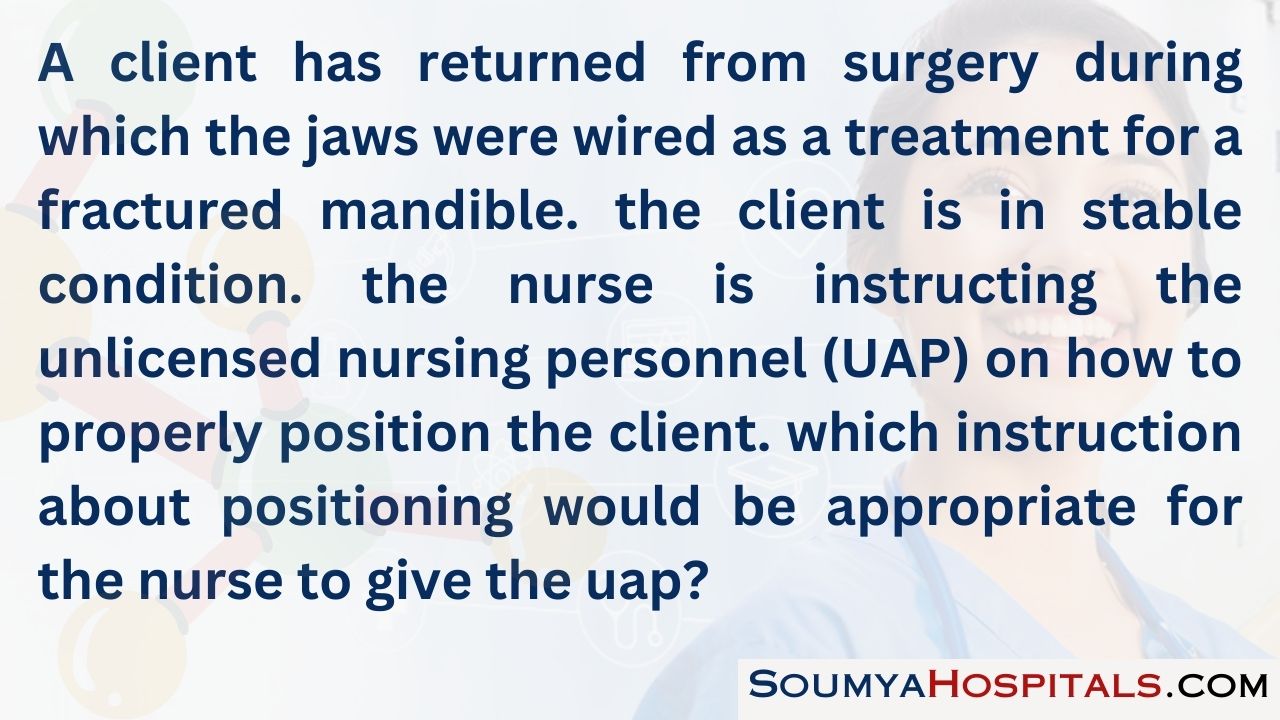
Explanation:
Immediately after surgery, the client should be placed on the side with the head slightly elevated. This position helps facilitate the removal of secretions and decreases the likelihood of aspiration should vomiting occur. An RN Q does not need to be present to reposition the client unless the client’s condition warrants the presence of the nurse. Although it is important to elevate the head, there is no need to keep the client’s head elevated on two pillows unless that position is comfortable for the client.
Question 52.
The nurse has been assigned to provide care for four clients. In what order, from first to last, should the nurse assess these clients? All options must be used.
(a) a client awaiting surgery for a hiatal hernia repair at 1100
(b) a client with suspected gastric cancer who is on nothing-by-mouth (NPO) status for tests
(c) a client with peptic ulcer disease experiencing a sudden onset of acute stomach pain
(d) a client who is requesting pain medication 2 days after surgery to repair a fractured jaw
Answer:
(b) a client with suspected gastric cancer who is on nothing-by-mouth (NPO) status for tests
(d) a client who is requesting pain medication 2 days after surgery to repair a fractured jaw
(c) a client with peptic ulcer disease experiencing a sudden onset of acute stomach pain
(a) a client awaiting surgery for a hiatal hernia repair at 1100
Explanation:
(b), (d), (c), (a). The client with peptic ulcer disease who is experiencing a sudden onset of acute stomach pain should be assessed first by the nurse. The sudden onset of stomach pain could be indicative of a perforated ulcer, which would require immediate medical attention. It is also important for the nurse to thoroughly assess the nature of the client’s pain. The client with the fractured jaw is experiencing pain and should be assessed next. The nurse should then assess the client who is NPO for tests to ensure NPO status and comfort. Last, the nurse can assess the client before surgery.
Question 53.
The nurse is caring for a client who has just had an upper GI endoscopy. The client’s vital signs must be taken every 30 minutes for 2 hours after the procedure. The nurse assigns an unlicensed assistive personnel (UAP) to take the vital signs. One hour later, the UAP reports the client, who was previously afebrile, has developed a temperature of 101.8°F (38.8°C). What should the nurse do next?
(a) Promptly assess the client for potential perforation.
(b) Tell the assistant to change the thermometers and retake the temperature.
(c) Plan to give the client acetaminophen to lower the temperature.
(d) Ask the UAP to bathe the client with tepid water.
Answer:
(a) Promptly assess the client for potential perforation.
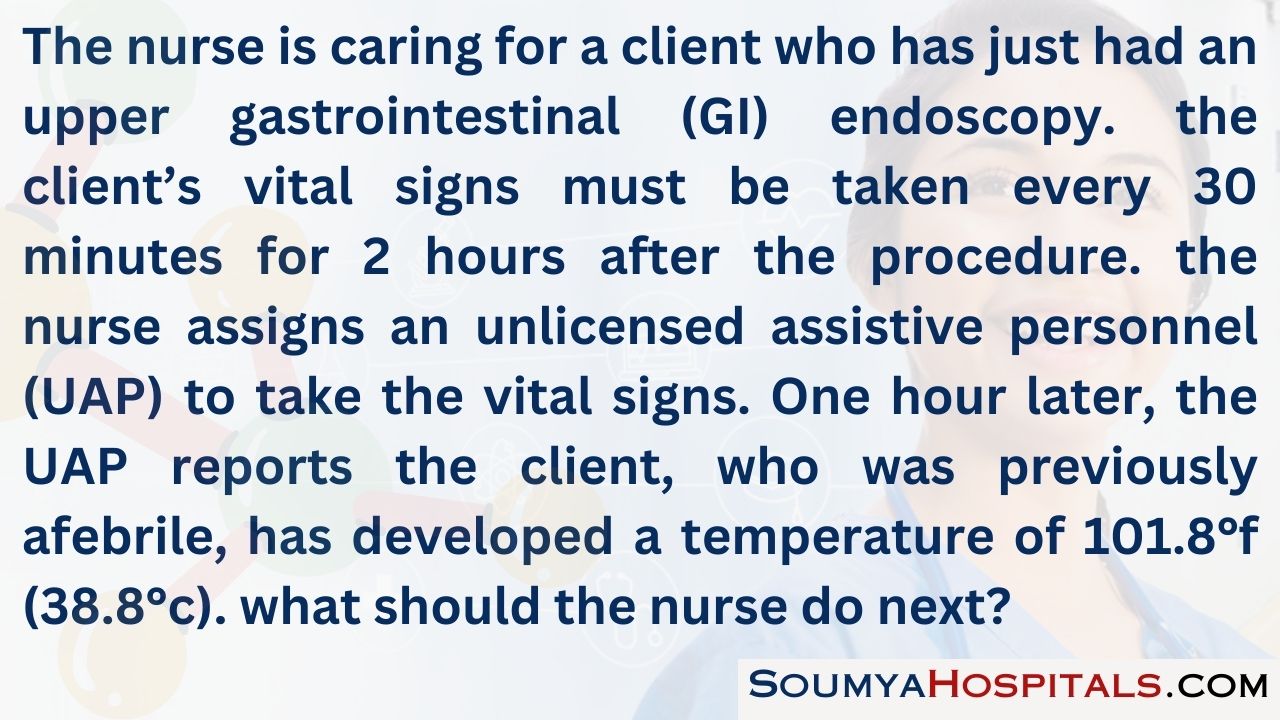
Explanation:
A sudden spike in temperature following an endoscopic procedure may indicate perforation of the GI tract. The nurse should promptly conduct a further assessment of the client, looking for further indicators of perforation, such as a sudden onset of acute upper abdominal pain; a rigid, board-like abdomen; and developing signs of shock.
Telling the assistant to change thermometers is not an appropriate action and only further delays the appropriate action of assessing the client. The nurse would not administer acetaminophen without further assessment of the client or without a health care provider’s (HCP’s) prescription; a suspected perforation would require that the client be placed on nothing-by-mouth status. Asking the assistant to bathe the client before any assessment by the nurse is inappropriate.
Question 54.
Which hospitalized client is at risk of developing parotitis?
(a) a 50-year-old client with nausea and vomiting who is on nothing-by-mouth status
(b) a 75-year-old client with diabetes who has ill-fitting dentures
(c) an 80-year-old client who has poor oral hygiene and is dehydrated
(d) a 65-year-old client with lung cancer who has a feeding tube in place
Answer:
(c) an 80-year-old client who has poor oral hygiene and is dehydrated
Explanation:
Parotitis is inflammation of the parotid gland. Although any of the clients listed could develop parotitis, given the data provided, the one most likely to develop parotitis is the elderly client who is dehydrated with poor oral hygiene. Any client who experiences poor oral hygiene is at risk for developing parotitis. To help prevent parotitis, it is essential for the nurse to ensure the client receives oral hygiene at regular intervals and has an adequate fluid intake.
Question 55.
The nurse instructs the unlicensed assistive personnel (UAP) on how to provide oral hygiene for clients who cannot perform this task for themselves. Which technique should the nurse ask the UAP to incorporate into the client’s daily care?
(a) Assess the oral cavity each time mouth care is given and record observations.
(b) Use a soft toothbrush to brush the client’s teeth after each meal.
(c) Swab the client’s tongue, gums, and lips with a soft foam applicator every 2 hours.
(d) Rinse the client’s mouth with mouthwash several times a day.
Answer:
(b) Use a soft toothbrush to brush the client’s teeth after each meal.
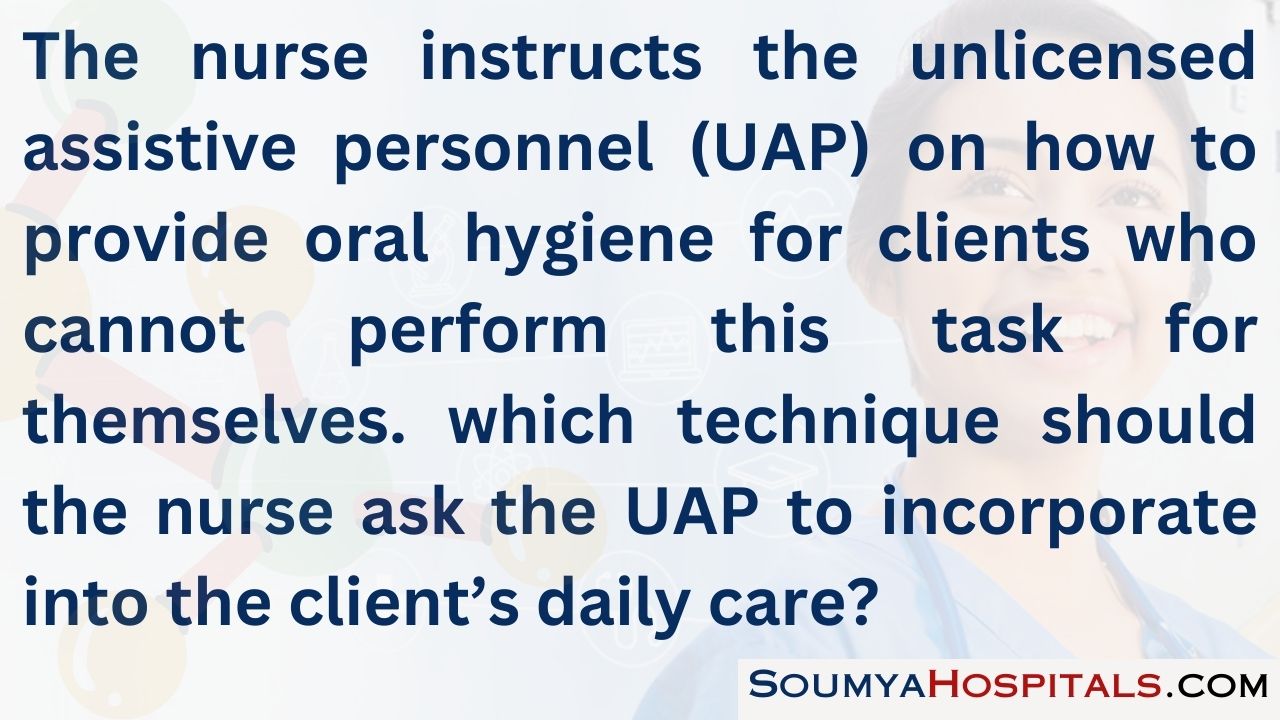
Explanation:
A soft toothbrush should be used to brush the client’s teeth after every meal and more often as needed. Mechanical cleaning is necessary to maintain oral health, stimulate gingiva, and remove plaque. Assessing the oral cavity and recording observations are the responsibilities of the nurse, not of the UAP. Swabbing with a safe foam applicator does not provide enough friction to clean the mouth. Mouthwash can be a drying irritant and is not recommended for frequent use.
Question 56.
The nurse is developing standards of care for a client with gastroesophageal reflux disease and wants to review current evidence for practice. Which resource will provide the most helpful information?
(a) a review in the Cochrane Library
(b) a literature search in a database, such as the Cumulative Index to Nursing and Allied Health Literature (CINAHL)
(c) an online nursing textbook
(d) the policy and procedure manual at the health care agency
Answer:
(a) a review in the Cochrane Library
Explanation:
The Cochrane Library provides systematic reviews of healthcare interventions and will provide the best resource for evidence for nursing care. The CINAHL offers keyword searches to published articles in nursing and allied health literature, but not reviews. A nursing textbook has information about nursing care, which may include evidence-based practices, but textbooks may not have the most up-to-date information. While the policy and procedure manual may be based on evidence-based practices, the most current practices will be found in evidence-based reviews of the literature.
Question 57.
The nurse in the intensive care unit is giving a report to the nurse in the postsurgical unit about
a client who had a gastrectomy. What is the most effective way for the nurse to ensure essential information about the client is reported?
(a) Give the report face-to-face with both nurses in a quiet room.
(b) Audiotape the report for future reference and documentation.
(c) Use a checklist with information individualized for the client.
(d) Document essential transfer information in the client’s electronic health record.
Answer:
(c) Use a checklist with information individualized for the client.
Explanation:
Using a checklist assures that all key information is reported; the checklist can then serve as a record to which nurses can refer later. Giving a verbal report leaves room for error in memory; using an audiotape or an electronic health record requires nurses to spend unnecessary time retrieving information.
Question 58.
A nurse is delegating activities to unlicensed assistive personnel (UAP). Which activities can be appropriately delegated? Select all that apply.
(a) Assist client with oral care prior to breakfast.
(b) Ask about location, quality, and radiation of pain.
(c) Observe and document effect of medication after given by the nurse.
(d) Measure and record intake and output throughout the shift.
(e) Determine if client is oriented to person, place, and time and report to nurse.
(f) Change a simple dry dressing on a client’s coccyx while bathing.
Answer:
(a) Assist client with oral care prior to breakfast.
(d) Measure and record intake and output throughout the shift.
Explanation:
(a), (d). Though still responsible for follow-up to make sure oral care is completed and accurate intake and output is ongoing, these are appropriate tasks to delegate to UAP. Evaluating level of consciousness (orientation), pain, and the effect of medications given by the nurse requires nursing judgment and should not be delegated to UAP. While UAP often assist clients with bathing, dressing changes are not delegated to UAP as the wound should be assessed by a nurse while changing the dressing.
Question 59.
The care of which client can be assigned to an unlicensed assistive personnel (UAP)?
(a) a client with stomatitis who requires instruction about mouth care before discharge
(b) a client who is having radiation for cancer of the stomach and is to have the radiation site bathed with warm water, followed by an application of a moisturizer
(c) a client who had a gastric resection and has a nasogastric tube draining bright red blood
(d) a client who had abdominal surgery and requires wet-to-dry dressing changes
Answer:
(b) a client who is having radiation for cancer of the stomach and is to have the radiation site bathed with warm water, followed by an application of a moisturizer
Explanation:
The care of the client who is having radiation treatments and requires skin care at the site that involves bathing and application of a nonmedicated moisturizer is within the scope of practice for the UAP. Discharge planning, assessing drainage, and changing wet-to-dry dressings are nursing care activities that must be performed by a licensed nurse.
Read More:
